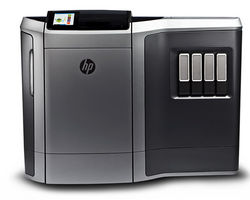- Commercial 3D printers & additive manufacturing solutions
- Order sample print
HP Multi Jet Fusion 3D Printer - 28 Nov 2014
HP's NEW in-house Multi Jet Fusion 3D Printer technology looks to deliver a new Benchmark to the world of full colour 3D printing.
Having already made a foray in to the 3D print market in 2010 under a European OEM agreement with market leader Stratasys which saw the HP Designjet 3D Printer and HP Designjet 3D Color Printer launch across 6 European countries, HP are set to launch their own technology featuring innovative technology.
The headline is all about Speed, Quality and Cost with HP stating that their Muti jet Fusion 3D printer will deliver an outstanding speed of 30 million material drops per second at just 21 micron, during benchmark product testing the HP machine delivered 1000 3D Printer Gears in just 3 hours compared to 38 Hours for Laser Sintering and 83 Hours for Material Extrusion. The benchmark information did not reveal against what devices were tested, however, the 3 hour turnaround time could if the materials are fit for purpose change the landsacpe of Direct Digital Manufacturing forever.
How the HP 3d Printer Works
As with many 3D printing processes, HP Multi Jet FusionTM technology starts by laying down a thin layer of material in the working area. Next, the carriage containing an HP Thermal Inkjet array passes from left-to-right, printing chemical agents across the full working area. The layering & energy processes are combined in a continuous pass of the second carriage from top-to-bottom. The process continues, layer-by-layer, until a complete part is formed. At each layer, the carriages change direction for optimum productivity.
Using HP Thermal Inkjet arrays with their high number of nozzles per inch, HP’s proprietary synchronous architecture is capable of printing over 30 million drops per second across each inch of the working area.
HP Multi Jet FusionTM technology—materials collaboration
HP’s first commercial product using HP Multi Jet FusionTM technology plans to build parts using production thermoplastic materials. Ultimately, HP are deterimned through their open platform approach to provide ceramics and metals and because this technology uses HP’s Thermal Inkjet arrays, it has all the advantages that come with discretion of drops. By controlling the properties of each individual volumetric pixel (or voxel) through chemical agents and their interaction with build materials, HP’s Multi Jet FusionTM technology can enable parts production of designs that potentially can’t be made by other
methods.
To realize this full potential of 3D printing, HP’s vision is to develop a 3D printing platform designed to become an industry standard, and HP is open to creative collaboration partnerships for 3D printing materials. These breakthroughs in materials & agent-material interactions can power the widespread adoption of 3D design and hardware innovation resulting in a digital transformation of manufacturing as widespread and profound as the way HP’s Thermal Inkjet solutions changed traditional printing & disrupted the market place.
How Big will the Build Envelope be?
Stacking HP Thermal Inkjet arrays across the width of the scan axis allows HP to build 3D printing solutions with working areas ranging from 110mm - to more than 1 meter wide which they have already proved in many of their inkjet process such as teh Designjet Printer range and their Web Press products.
Furthermore, Stacking HP Thermal Inkjet arrays along the scan direction provides more nozzles for increased writing speed and/or additional functionality from adding different types of liquid agents.
Summary
Based on HP’s core competencies in precision, low-cost mechanics, precision metering and placement of liquid agents, high-volume manufacturing, and material science, HP is poised to introduce a disruptive 3D printing technology.
Comparison to commercially available 3D printing technologies has demonstrated advantages to HP Multi Jet FusionTM technology and its material set to define new levels of part quality, high part functionality, at potentially 10 times the build speed and at breakthrough cost dependant upon material.
A key feature of HP Multi Jet FusionTM technology is the potential to modify material properties to produce controlled-variability in mechanical and physical characteristics within a part. This can enable a host of new possibilities in the design and performance of parts built by 3D printing.
HP’s entry into 3D printing includes realizing HP’s vision of a 3D printing ecosystem with advanced user interfaces, software for 3D part creation and production, and 3D printers optimized to deliver an end-to-end experience with the potential to drive the digital transformation of manufacturing.
 Worcester (Head Office) 01905 458 000
Worcester (Head Office) 01905 458 000 3d@stanfordmarsh.co.uk
3d@stanfordmarsh.co.uk











